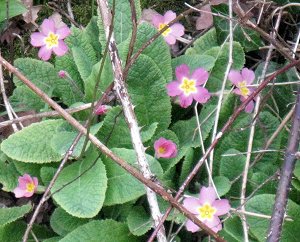In Brief
SE74U - Barmby Moor
A total of 80 species was recorded in Barmby Moor, St Catherine's churchyard, mainly from on and around gravestones, and in the adjacent lane.
Peter Cook, 15 October 2015
SE74Z - Pocklington Airfield
Business on the Pocklington Airfield Industrial Estate enabled some brief botanizing on a few open spaces in SE74Z with a score of 52 species. Although situated in a non-target tetrad this industrial site has potential to yield a significant list and some interesting additions to an already impressive hectad total.
Peter Cook, 15 October 2015
TA32J Owthorne/Waxholme
A few days miss-spent on the urban streets, caravan parks, tracks, cliff-top and arable field margins to the north of Withernsea on various occasions through this year has yielded a respectable score of 179 species for this non-target tetrad.
Peter Cook, 15 October 2015
TA41C - Kilnsea Canal
A stroll along the Humber bank and its silted up borrow pit between Sammy's Point and the hotel at Kilnsea yielded only 14 additional records for this target tetrad, raising the total to 175. A significant find was a new site for the rare Sea Rush Juncus maritimus, which is now known to occur at three different locations in TA41C, but nowhere else. The hybrid restharrow Ononis x pseudohircina was re-found with both parents not far away and remnants of Narrow-leaved bird's-foot-trefoil Lotus glaber were noted.
Peter Cook, 8 October 2015
TA07P - Flixton/Folkton
With only 11 taxa in the database, taken from grassland survey quadrats on 13 August 2012, supplementary records noted from the village hall car park at Flixton and on the steep climb up to the wold brow added only a further 56. There is very little accessible habitat in this square and it will be hard work to push the tetrad total to more than 100, and contribute to the TA07 hectad total.
Peter Cook, 24 Sept. 2015
16S - South Bridlington (again!)
Survey of a small area of dune yielded 38 taxa in May this year and survey again with extension to Wilsthorpe and excursion into open, disturbed soil on the cliff top yielded a total of 112 taxa with expectation of boosting the hectad total.
Peter Cook, 23 Sept. 2015
TA16R - Wilsthorpe
This is not a target tetrad but 90 taxa, some of which may contribute to the hectad total, were recorded on a 100 m x 25 m strip of very eroded dune system between the beach and the low cliff top. Again, Rosa rugosa was noted in another coastal tetrad.
Peter Cook, 23 Sept. 2015
TA15U and TA16Q - Barmston
Land straddling the boundary of two tetrads produced lists of 57 and 56 taxa respectively including Japanese Rose Rosa rugosa naturalized on the sand dunes and Red Goosefoot Chenopodium rubrum in reedbeds in both tetrads. The best find was a Fool's Parsley taxon, Aethusa cynapium subsp. agrestis, found in wheat stubble in TA16Q.
Peter Cook, 18 Sept. 2015
TA24C - Rolston
Bill and Janet have provided an impressive list of 160 plants for this unrecorded, selected, tetrad. This adds 32 spots to Atlas 2020.
3 September 2015
TA06A - Driffield Wold
A list from Bill and Janet Dolling has added 106 records for this unrecorded, selected, tetrad. A seemingly modest total but accurately reflecting the area's low diversity. Never the less 9 new atlas spots were added to the hectad.
3 September 2015
SE84G - Thorpe Whin
A list from Rohan Lewis and Gabrielle Jarvis has rasied the total for this selected tetrad from a measly 1 to a very respectable 140.
12 August 2015
TA21J - Stone Creek
A walk along the embankment on the western (upriver) side and forays into the saltmarsh yielded twelve extra species for the tetrad. These were, in no particular order: Torilis japonica, Angelica sylvestris, Mycelis muralis, Valeriana officinalis, Plantago maritima, Limonium vulgare, Atriplex prostrata, Spartina anglica, Glaux maritima, Vicia sepium, Sonchus arvensis and Helminthotheca echioides.
Bill & Janet Dolling, 8 August 2015
There is still a lot to do along the Humber saltmarshes and in the borrow dykes and berms - would anyone like some September Local Group meeting to do the eastwards stretches from Stone Creek and/or westwards from Welwick pump? Peter Cook
SE76Q - Leppington
We made a flying visit to this untouched selected tetrad today while on the way for lunch in Kirkham. We only had chance to look at the north-west monad but managed to notch up 115 taxa in little over an hour. The best finds were probably Pepper-saxifrage (Silaum silaus) and Agrimony (Agrimonia eupatoria) found, along with one or two other interesting plants, on a pocket-handkerchief sized patch of verge. Another visit is needed to this tetrad, preferably a little earlier in the year.
The local group's recording efforts on SE76 have already added 95 new atlas spots this season.
R. & K. Middleton, 31 July 2015
TA41 - Easington Seaside
This selected tetrad of only 1.5 monads land area had a lot of coverage last year with surveys of urban and caravan park areas and the species-rich dunes, which yielded a very respectable 165 taxa for such a small area. I felt that I had not given enough time to small areas of arable, road verge and hedgerow habitats which was evident in the absence of some banal species. A walk yesterday added 18 new taxa to the list taking it tantalizingly close to the gold standard of 200 taxa.
Peter Cook, 27 July 2015
SE82M - Blacktoft
A visit to this selected tetrad by Rohan Lewis has added 120 plants to this previously under-recorded square. Of particular note was a single plant of Lotus tenuis. Total now 132.
23 July 2015
TA14C - Leven
Previously standing at 155, the list for this selected tetrad has been extended to 203 by an evening visit to the canal and village.
Richard Middleton, 22 July 2015
SE94P - Middleton-on-the-Wolds
Rohan Lewis' recent visit to this selected tetrad has add 99 new taxa to the list. 22 new taxa were added to the hectad total.
20 July 2015
TA02T - St Andrew's Quay
A list contributed by the Hull Natural History Society has added a further 30 taxa to this selected tetrad pushing it into the "gold" category.
8 July 2015
SE86N - North Grimston
As impressive list from Gabrielle Jarvis has more than doubled the number of taxa recorded for this tetrad taking it comfortably into the "gold" category at 212. Almost 30 new taxa were added to hectad SE86, the total now standing above 400.
6 July 2015
SE95X - Southburn
A network of paths leads one from farm buildings through shelter-belt plantation to field margins alongside arable crops and willow biofuel stands to a small area of fen and marsh on the R. Hull Headwater SSSI. Here Glyceria declinata and Stachys palustris were the best finds. A total of 144 banal ruderal, field margin and tall-herb species was recorded in a route entirely within this non-target tetrad.
Peter Cook, 27 June 2015
TA03E Westwood
A list from Rohan Lewis for the area near Swadgery Mere Wood has raised the number of taxa for this tetrad by over 40 taxa, giving a new total of 140. It also added seven to the hectad total which now stands at an impressive 630.
Richard Middleton, 23 June 2015
TA16T Bridlington
I took advantage of the warm weather this morning to attempt to improve the total for this selected tetrad; three hours searching managed to increase the total from 75 to 163. Not quite the "gold" standard but probably a reasonable indication of its diversity.
Richard Middleton, 4 June 2015
SE87X East Knapton
Kath and myself visited this selected, but unrecorded, tetrad today and managed to discover 135 plants. Nothing particularly special but plenty of Cerastium arvense and a little Filipendula vulgaris, Helianthemum nummularium and Polygala vulgaris along the Wolds Way.
This modest recording session added 30 new atlas spots.
Richard Middleton, 30 May 2015
SE93E - Sancton
A visit to this area by the East Yorkshire Botany Club has raised the tetrad total to 221, promoting it to our 'gold' standard
SE96K - West of Sledmere Monument & Black Wood
Less than one hour of recording was crammed into a dog walking session along the track leading West to Black Wood, in this non-target tetrad, taking in rank and tall-herb trackside flora and some arable (wheat) margins. A total of 95 species was recorded. In Black Wood, wood forget-me-not Myosotis sylvatica occurred in profusion with varieties with flowers ranging from all blue, all white and all pink flowers and also many plants with first-opened flowers of the corymb in blue and later-opened flowers pink suggesting origin as an alien escape rather than 'true native' origin. (PJC)
TA22Y - Winestead High Wood
A brief call-in at a location known for Rhododendron ponticum, Athyrum filx-femina and Anemone nemorosa yielded a respectable 54 species in less than ten minutes in a bid to raise the hectad score to more than 500. (PJC)
TA22U - Roos Bog and adjacent arable
This geological SSSI, a kettle-hole, was visited in 2002 accompanying entomologists. A total of 78 plant taxa was recorded, the notable being Scutellaria galericulata and Carex rostrata. Adjacent arable field margins were typical of intensive agricultural practice although a grassy buffer zone around the bog provided some diversity. (PJC)
TA32E - Rimswell
This non-target tetrad is visited frequently on dog-walking jaunts and has been recorded quite thoroughly to produce a respectable 175 taxa. (PJC)
TA16S - Bridlington Bay South
A small area of sand dune alongside the Bridlington Park-and-Ride carpark was the source of a list of 38 taxa including sea mouse-ear Cerastium diffusum. (PJC)
TA22S - Ottringham Village
Time spent waiting like a pregnant father for the car MOT test to finish was passed wisely recording in the village of Ottringham where waste ground near both village halls and the churchyard, road verges near the bus stop and small areas of open ground yielded a respectable score of 97 species. Most notable was a single Asplenium ruta-muraria on the wall of St Oswald's Church, Hordeum murinum at the bus stop where the species is very often found and several Epilobium tetragonum plants with Urtica urens on fine rubble near the old village hall. (PJC)
TA23V - Roos Village
This non-target square has been botanised on several occasions over the years with many records noted on visits to resident family and friends. A total of 178 taxa have accumulated, most of which are banal. (PJC)
SE63
New data for the Hollicarrs Wood area, provided by David Broughton, has added over 20 new atlas spots.
18 May 2015
TA23P - Aldbrough
A list from Bill Dolling has added 23 new plants to the tetrad list bringing the total up to 131.
18 May 2015
TA41B - Chalk Bank, Spurn
Data from Peter Cook's 2000 report on the site has been added to the database, boosting the tetrad total to 106 from 44.
1 May 2015
SE85G - Millington Wood
The combination of a list contributed by the East Yorkshire Botany Club and a list for 2010 that Peter found "down the back of the sofa", has boosted the tetrad total to a useful 182.
24 April 2015
SE95
Records contributed by Rohan Lewis from a walk in the area have increased the totals for SE95C to 91 and SE95G to 56. The hectad total now stands at 278, an increase of seven atlas spots.
23 April 2015
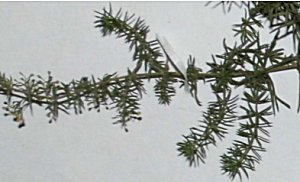 There has long been known a variety of Lady's Bedstraw Galium verum var. maritimum that grows on sand-dunes and sea- cliffs. I have known it on the grey dune at Sammy's Point, TA3916, for several years and as a variety it has never been formally recorded in vc61. On receipt of the BSBI Atlas 2020 Notes on identification works etc. received this week I noted that this variety has been promoted to subspecies status after Sell & Murrell. In passing today, I stopped to collect a small voucher specimen. It is a dwarf, sprawling, prostrate plant with the leaves distinctly longer than the distance between whorls (internodes). The photograph does not show the whole plant but the leaf-internode length relationship is clearly visible. It is a plant worth looking out for.
There has long been known a variety of Lady's Bedstraw Galium verum var. maritimum that grows on sand-dunes and sea- cliffs. I have known it on the grey dune at Sammy's Point, TA3916, for several years and as a variety it has never been formally recorded in vc61. On receipt of the BSBI Atlas 2020 Notes on identification works etc. received this week I noted that this variety has been promoted to subspecies status after Sell & Murrell. In passing today, I stopped to collect a small voucher specimen. It is a dwarf, sprawling, prostrate plant with the leaves distinctly longer than the distance between whorls (internodes). The photograph does not show the whole plant but the leaf-internode length relationship is clearly visible. It is a plant worth looking out for.
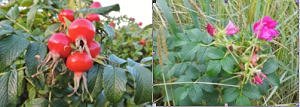 The alternative name, "Sea Tomato", is apt with the large luscious red fruits and love of growing by the sea. As a one-time denizen of Suffolk I often saw this plant apparently naturalized on dunes and sometimes on the beach as far down as the strandline. There is an old coastal record for Tunstall, presumably Sand-le-Mere, and a more recent one South of Bridlington. Over the last few years I have botanized all our scarce resource of dunes and now have records for R. rugosa from all of them between Bridlington and Spurn where, in each place, the plant seems to be comfortably at home spreading vegetatively and, at Easington with certainty, by seed. I suspect that our coastal plants arrived naturally as fruit in flotsam. They look determined to stay and hopefully will not spread and overwhelm dune integrity.
The alternative name, "Sea Tomato", is apt with the large luscious red fruits and love of growing by the sea. As a one-time denizen of Suffolk I often saw this plant apparently naturalized on dunes and sometimes on the beach as far down as the strandline. There is an old coastal record for Tunstall, presumably Sand-le-Mere, and a more recent one South of Bridlington. Over the last few years I have botanized all our scarce resource of dunes and now have records for R. rugosa from all of them between Bridlington and Spurn where, in each place, the plant seems to be comfortably at home spreading vegetatively and, at Easington with certainty, by seed. I suspect that our coastal plants arrived naturally as fruit in flotsam. They look determined to stay and hopefully will not spread and overwhelm dune integrity.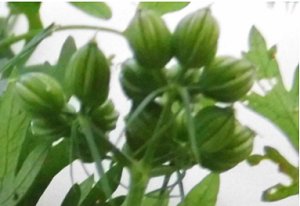 While walking along a wheat stubble margin near Barmston, TA16Q, on 16 September I saw a patch of at least 50 small ~13cm) sub-erect umbellifer plants and thought it to be Shepherd's Needle until I saw the fruit. I'd read of the existence of several subspecies of Fool's Parsley so sacrificed a voucher specimen. Our usual plant, Aethusa cynapium subsp. cynapium, is erect and may attain heights of 1 m with its longest pedicels less than half the length of the bracteoles, and fruiting pedicels twice as long as the fruits. The taxon found here, A. cynapium subsp. agrestis, is very different in never being more than 20 cm high and with longest pedicels about the same length as the bracteoles and fruiting pedicels shorter than the fruits. The photograph above, though slightly out of focus, shows this fairly clearly. BSBI maps show this to be a mainly southern taxon although it has been recorded near to us in vcs 62 and 64.
While walking along a wheat stubble margin near Barmston, TA16Q, on 16 September I saw a patch of at least 50 small ~13cm) sub-erect umbellifer plants and thought it to be Shepherd's Needle until I saw the fruit. I'd read of the existence of several subspecies of Fool's Parsley so sacrificed a voucher specimen. Our usual plant, Aethusa cynapium subsp. cynapium, is erect and may attain heights of 1 m with its longest pedicels less than half the length of the bracteoles, and fruiting pedicels twice as long as the fruits. The taxon found here, A. cynapium subsp. agrestis, is very different in never being more than 20 cm high and with longest pedicels about the same length as the bracteoles and fruiting pedicels shorter than the fruits. The photograph above, though slightly out of focus, shows this fairly clearly. BSBI maps show this to be a mainly southern taxon although it has been recorded near to us in vcs 62 and 64.
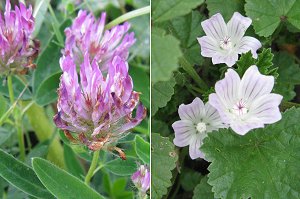
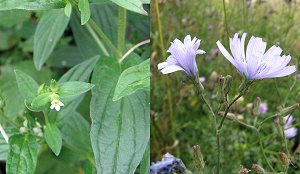
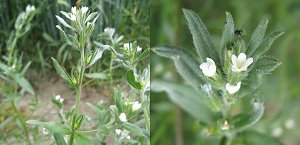
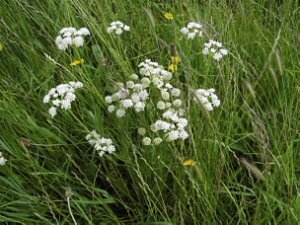
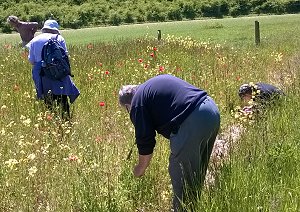
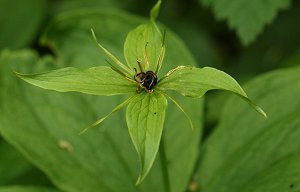 We were delighted to hear that Paris quadrifolia has been re-discovered in East Yorkshire - Ken White has found a thriving colony of this plant growing in a wood near Jeffry Bog. This is the first record in the vice-county this millennium and improves its status from "regionally extinct" to "rare".
We were delighted to hear that Paris quadrifolia has been re-discovered in East Yorkshire - Ken White has found a thriving colony of this plant growing in a wood near Jeffry Bog. This is the first record in the vice-county this millennium and improves its status from "regionally extinct" to "rare".
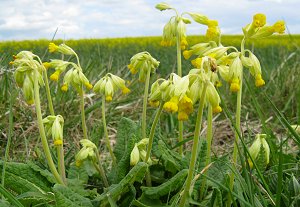
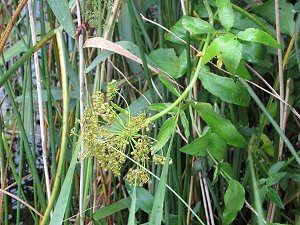 Dr Ray Goulder has re-found the Greater Water-parsnip in Leven Canal. The above picture shows a single plant at the canal edge near Sandholme Bridge. Also seen were Hottonia palustris (Water Violet) and Utricularia vulgaris (Bladderwort).
Dr Ray Goulder has re-found the Greater Water-parsnip in Leven Canal. The above picture shows a single plant at the canal edge near Sandholme Bridge. Also seen were Hottonia palustris (Water Violet) and Utricularia vulgaris (Bladderwort).
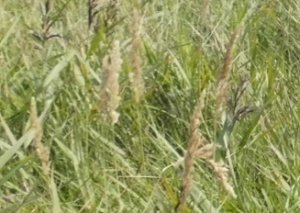 Wood Small-reed Calamagrostis epigejos (now epigeios) occurs in and around Hull in waste places near docks and on road verges. On the west side of the vice county it occupies damp woods, ditches and fens. According to descriptions in many sources these are the natural habitats for the species. It has also long been known as a grass of dune slacks and coastal grassland throughout the Baltic and N European coasts where it occurs with or near Marram and possibly in its natural association. What a pleasant surprise it was to find a substantial (5m x 5m) stand of C. epigeios growing seemingly 'at home' with Common reed Phragmites australis, Sea Couch Elytrigia atherica and Wild celery Apium graveolens on the slack of Marram dunes at the Beacon Lagoons Nature Reserve at TA413168. This find helps to substantiate a description of NVC S24 as one of many here that contribute significantly to their designation as Priority Habitat BH19 supralittoral sediment. In any case, this is a 'good find' to start the month.
Wood Small-reed Calamagrostis epigejos (now epigeios) occurs in and around Hull in waste places near docks and on road verges. On the west side of the vice county it occupies damp woods, ditches and fens. According to descriptions in many sources these are the natural habitats for the species. It has also long been known as a grass of dune slacks and coastal grassland throughout the Baltic and N European coasts where it occurs with or near Marram and possibly in its natural association. What a pleasant surprise it was to find a substantial (5m x 5m) stand of C. epigeios growing seemingly 'at home' with Common reed Phragmites australis, Sea Couch Elytrigia atherica and Wild celery Apium graveolens on the slack of Marram dunes at the Beacon Lagoons Nature Reserve at TA413168. This find helps to substantiate a description of NVC S24 as one of many here that contribute significantly to their designation as Priority Habitat BH19 supralittoral sediment. In any case, this is a 'good find' to start the month.
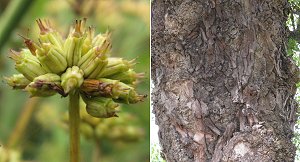 An interesting visit to this little-frequented part of the vice-county. The most significant find was, undoubtedly, Hemlock Water-dropwort (Oenanthe crocata), seed head pictured above left, which occurred both on the river bank and in a ditch near Laxton. Again near the river bank was an interesting Poplar tree which, although undoubtedly planted, the burry trunk (above right) showed to be the native Black Poplar (Populus nigra subsp. betulifolia).
An interesting visit to this little-frequented part of the vice-county. The most significant find was, undoubtedly, Hemlock Water-dropwort (Oenanthe crocata), seed head pictured above left, which occurred both on the river bank and in a ditch near Laxton. Again near the river bank was an interesting Poplar tree which, although undoubtedly planted, the burry trunk (above right) showed to be the native Black Poplar (Populus nigra subsp. betulifolia).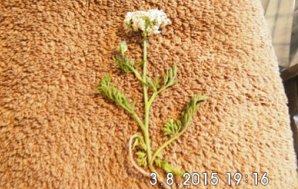
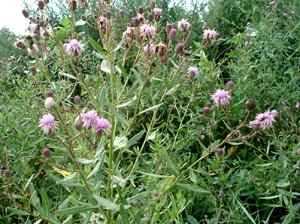
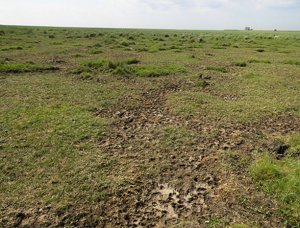
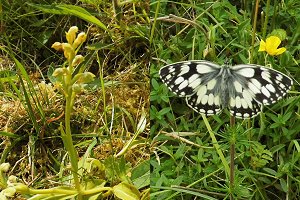
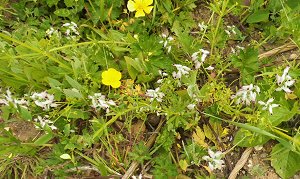 This site was visited on 26 June as part of one of Yorkshire Coast Nature's Botany Days. It is a new wetland reserve on Thornwick Farm Holiday Centre which is part sponsored by Wold Ecology Ltd. Much of the grassland area is naturally regenerated flora on compressed clay moved in the excavation of ponds. Low areas are impervious and encrusted with the cup lichen Cladonia fimbriata with scattered Blackstonia perfoliata and Centaurium erythraea representing a 'combo' ideal for bee orchid but, after much searching, none was found. However, looser bare soil was occupied by some scarce arable weeds such as Stachys, Viola and Spergula arvensis , and Fallopia convolvulus. Longer grass contained Dactylorrhiza purpurea, Koeleria macrantha betraying the chalky substrate, and both Vicia tetrasperma and V. hirsuta with abundant and sometimes luxuriant Trifolium campestre. The most significant find was Fumaria parviflora (picture). Not recorded was a suite of wildflower mix species and patently planted shrubs, and the complete list was reduced to those species not recorded on 18 April, pushing the overall tetrad total above the 'gold standard' of 200 with some notable finds.
This site was visited on 26 June as part of one of Yorkshire Coast Nature's Botany Days. It is a new wetland reserve on Thornwick Farm Holiday Centre which is part sponsored by Wold Ecology Ltd. Much of the grassland area is naturally regenerated flora on compressed clay moved in the excavation of ponds. Low areas are impervious and encrusted with the cup lichen Cladonia fimbriata with scattered Blackstonia perfoliata and Centaurium erythraea representing a 'combo' ideal for bee orchid but, after much searching, none was found. However, looser bare soil was occupied by some scarce arable weeds such as Stachys, Viola and Spergula arvensis , and Fallopia convolvulus. Longer grass contained Dactylorrhiza purpurea, Koeleria macrantha betraying the chalky substrate, and both Vicia tetrasperma and V. hirsuta with abundant and sometimes luxuriant Trifolium campestre. The most significant find was Fumaria parviflora (picture). Not recorded was a suite of wildflower mix species and patently planted shrubs, and the complete list was reduced to those species not recorded on 18 April, pushing the overall tetrad total above the 'gold standard' of 200 with some notable finds.
.jpg)
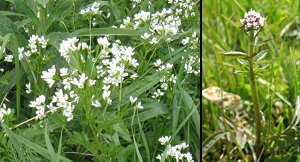
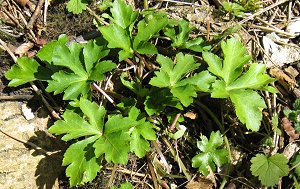
.jpg)
